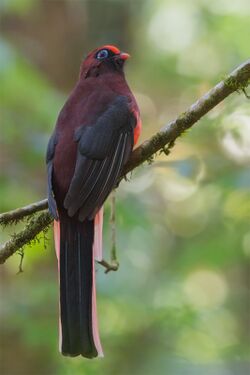Biology:Ward's trogon
| Ward's trogon | |
|---|---|

| |
| Male in Eaglenest Wildlife Sanctuary | |
| Scientific classification | |
| Domain: | Eukaryota |
| Kingdom: | Animalia |
| Phylum: | Chordata |
| Class: | Aves |
| Order: | Trogoniformes |
| Family: | Trogonidae |
| Genus: | Harpactes |
| Species: | H. wardi
|
| Binomial name | |
| Harpactes wardi (Kinnear, 1927)
| |
Ward's trogon (Harpactes wardi) is a species of bird in the family Trogonidae. Its range includes the northeastern parts of the Indian subcontinent stretching eastwards to Southeast Asia. It is found in Bhutan, India , Tibet, and Myanmar. It also has a disjunct population in northern Vietnam, but there are no recent records from there. Its natural habitats are temperate forests and subtropical or tropical moist lowland forests. It is threatened by habitat loss.
Its common name and Latin binomial commemorate the English botanist and explorer Francis Kingdon-Ward.[2]
Description
Ward's trogon measures 35 to 38 cm (14–15 in) in length and weighs 115–120 g (4.1–4.2 oz). The male have a pink-red breast, belly, undertail and forehead and the chest, back and wings and uppertail are dark slate with a maroon wash. The tip of the bill is deep red. The plumage of the female matches the male but the red is replaced with yellow and the dark parts are dark olive. The female's beak tip is yellow, and both sexes have a blue ring around the eye.[3]
Distribution and habitat
Ward's trogon ranges from Bhutan and Arunachal in North Eastern India and into northern and eastern Myanmar and southern China (in western Yunnan). A disjunct population was reported to be common in Fan Si Pan in Vietnam in 1939, but there are no modern records of that species there. The species is generally montane, usually occurring between 1,500–3,200 m (4,900–10,500 ft) but occasionally coming down as low as 300 m (980 ft). There is some evidence that it moves to lower altitudes in winter.[3]
The preferred habitat of Ward's trogon is subtropical hill forest dominated by Quercus and Castanopis and temperate broadleaf evergreen forest. Within these forests it is found in the understory, undergrowth and within bamboo stands.[3]
The species is not a common one, although it can be locally common in some locations. It was treated as vulnerable by the IUCN in the 1990s, but secure populations have been found in Bhutan, so it is presently listed as near-threatened.[3]
Behaviour
Little is known about the behaviour of Ward's trogon. It feeds on insects, including moths, stick-insects, grasshoppers and bugs, as well as large seeds. Its nests have not been found or described, but birds in breeding condition have been found in March and April.[3]
References
- ↑ BirdLife International (2016). "Harpactes wardi". IUCN Red List of Threatened Species 2016: e.T22682857A92964837. doi:10.2305/IUCN.UK.2016-3.RLTS.T22682857A92964837.en. https://www.iucnredlist.org/species/22682857/92964837. Retrieved 12 November 2021.
- ↑ Beolens, Bo; Watkins, Michael (2003). Whose Bird? Men and Women Commemorated in the Common Names of Birds. London: Christopher Helm. p. 359.
- ↑ Jump up to: 3.0 3.1 3.2 3.3 3.4 Collar, N (2018). "Ward's Trogon (Harpactes wardi)". in del Hoyo, Josep; Elliott, Andrew; Sargatal, Jordi et al.. Handbook of the Birds of the World Alive. Barcelona: Lynx Edicions. https://www.hbw.com/species/wards-trogon-harpactes-wardi.
Wikidata ☰ Q1259010 entry
 |


